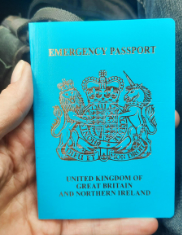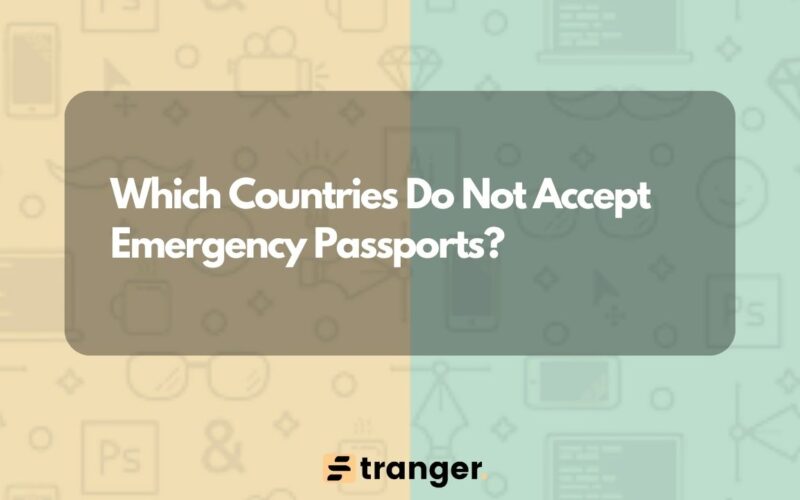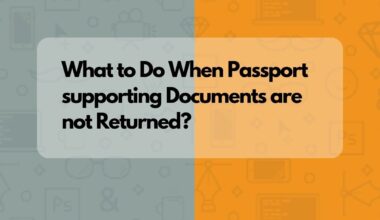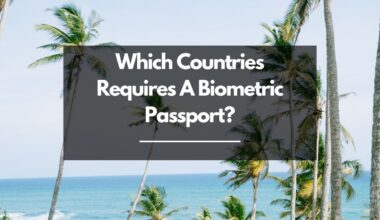As an Amazon Associate, I earn a small commission from qualifying purchases. Learn more about this.
In a perfect world, all countries would accept emergency passports.
But we live in a world with different rules.
If you’ve got an emergency passport, it’s crucial to know where it’s accepted. We’ve put together a list of countries where your emergency passport might not be welcomed.
Why Some Countries Don’t Accept Emergency Passports?
When it comes to international travel, each country sets its own rules and policies, especially regarding what type of travel documents they accept.
Emergency passports are a special case.

These are usually issued in a hurry, often lacking the usual security features of a regular passport, like biometric data.
Some countries are strict about this, insisting on higher levels of security in travel documents.
Another reason for non-acceptance is the validity period.
Emergency passports typically have a shorter validity period than regular passports.
Countries might be concerned about the risks associated with accepting a document that doesn’t undergo the usual rigorous checks and processes.
They worry about the potential for misuse or fraud.
Then there’s the issue of consistency in travel policies.
Some countries prefer to have a standardized approach to all types of passports and travel documents.
By not accepting emergency passports, they keep their immigration policies straightforward and reduce the complexity of handling various types of documents.
Moreover, diplomatic relations and international agreements also play a role.
Countries may decide on the types of passports they accept based on these broader political and diplomatic considerations.
Which Countries Do Not Accept Emergency Passports
| Country | Accepts Emergency Passport? | Notes |
|---|---|---|
| India | No | Regular visa and passport required. |
| Brazil | No | Strict with travel documents. |
| China | No | Prefers regular, biometric passports. |
| Russia | No | Strict entry requirements. |
| Vietnam | No | Regular passport mandatory. |
| Saudi Arabia | No | Strict on passport types. |
| South Africa | No | Prefers traditional passport. |
| United Arab Emirates | No | Biometric passport often required. |
| Turkey | No | Regular travel documents needed. |
| Thailand | No | Regular passport and visa needed. |
| USA | No | Does not accept extensions. |
| Portugal | No | Regular documents required. |
| Holland | No | Prefers standard passport. |
| Cyprus | No | Standard passport rules apply. |
| Mexico | No | Regular passport is a must. |
| Australia | No | Strict passport regulations. |
| Switzerland | No | Biometric passport often needed. |
| France | No | Regular passport required. |
| Belgium | No | Standard passport rules apply. |
Important Notes:
- This table is based on the current understanding of emergency passport acceptance as of 2023. It’s important to confirm with the respective country’s embassy or consulate before traveling, as regulations can change.
- Emergency passports are typically issued for urgent travel needs and have shorter validity periods than regular passports. Not all countries recognize them due to different immigration policies and requirements.
8 Tips for Travelling with an Emergency Passport
Traveling with an emergency passport can feel like navigating a maze. It’s different from using a regular passport, and it’s crucial to know the ropes. Here are some tips to help make your journey smoother.
1. Always Double-Check Country Entry Requirements: Before you pack your bags, the first step is to verify if your destination country accepts emergency passports. This isn’t just a ‘nice to do’ – it’s a must. A quick check with the country’s embassy or consulate can save you from a world of inconvenience.
2. Understand the Limitations of Your Passport: Emergency passports often have a shorter validity period and may lack some features of a regular passport. Be aware of these limitations. For instance, some countries might allow you entry but not a long stay.
3. Keep Your Travel Plans Flexible: With an emergency passport, it’s wise to stay adaptable. Flight changes or route adjustments might be needed if a transit country doesn’t accept your passport.
4. Have Your Documents in Order: Besides your emergency passport, ensure all other documents like visas (if required) and identification are in order. In my experience, having extra copies of important documents can be a lifesaver.
5. Be Prepared for Extra Scrutiny: It’s not uncommon for emergency passport holders to face additional questioning at immigration. Stay calm, be patient, and have a clear explanation for your situation and travel plans.
6. Consider Travel Insurance: Given the unpredictability of traveling with an emergency passport, investing in comprehensive travel insurance is a smart move. Look for policies that cover trip cancellations or interruptions.
7. Keep Updated on Travel Advisories: The world of travel is always changing. Keep an eye on travel advisories, especially related to the countries you plan to visit.
8. Have a Backup Plan: Lastly, be prepared for the unexpected. In case you’re denied entry, have a plan B. This could be an alternative destination or returning home.







